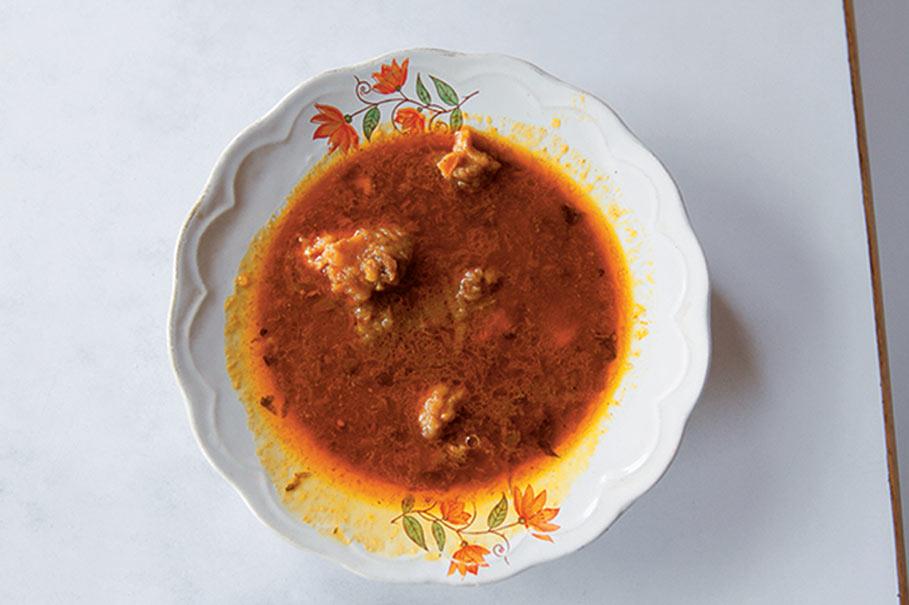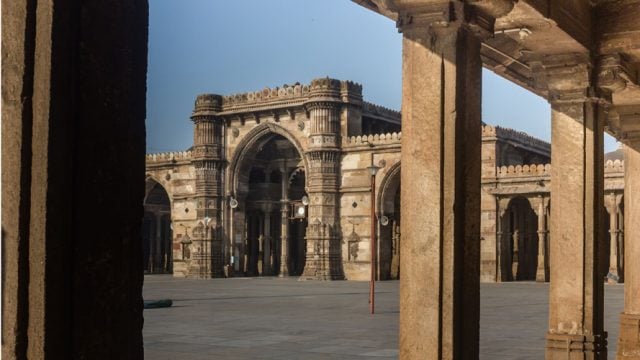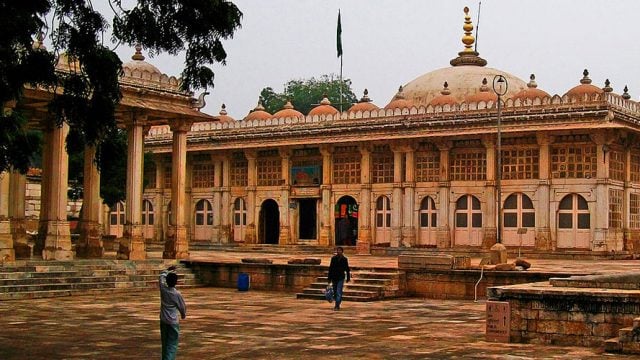Standing in that narrow strip of safety — an indeterminate zone between a stream of
The Teen Darwaza bazaar in Ahmedabad is a place of constant hubbub. Everywhere there are shrill shoppers and handcarts piled with fluorescent glasses and furry rugs. Gigantic pink teddy bears dangle from the branches of a dispirited tree. The evening azaan faces stiff competition from the thunk-thunk of hyperactive ladles. The aroma of frying fish quarrels with the not-so-polite odours of an overcrowded old city. Waves of heat emanate from a hundred frying pans, tavas and bhattis. A small crowd munches away near the chicken tikkawala, nimbly protecting toddlers and toes from demented scooties.
Feeling as if I’ve been trapped in one of those psychedelic ‘Only in India’ videos, I perform contortionist acts to save my plate of juicy tikkas from impatient elbows. At which point my guide Usman says apologetically, “No crowd now. After 9pm there’s no place to walk. That’s the time to come to Bhatiyar Gali.” To which I can only nod numbly as I skip out of the path of a wobbly motorcycle being driven by a man munching a sheekh kabab.
I am in Ahmedabad with a clear brief: to eat as the Amdavadis do. And I’m fast realising that in this exploding city of malls, minarets and mirror-work, this can be quite an adventure. For when it comes to the perfect khaman or kheema samosa, Amdavadis will risk limbs and combat crowds. In fact, if they were to get their daalwadas or royal kesar falooda too easily, they’d probably feel cheated. “Amdavadis are very shaukeen about food. On weekends you have to wait in line for a couple of hours outside restaurants. In our Navrangpura branch we have a Queue Manager just to handle crowds on Sundays,” says Bhavik Thakkar, scion of the popularDas Khaman (near the Municipal Corporation Office and in Navrangpura; 079-65416472). Adds Ashutosh Bhatt, of a new egg eatery called Eggstacy (Ambavadi; 40086342, 9825030303, 9712106060, 9712377677), “Ahmedabad has neither dariya, nor daaru. So what do people do for entertainment? They go to the multiplex or for a meal.”
Little wonder then that visitors willing to look beyond room service and food courts can stumble upon many gastronomic delights. The most startling of these is, of course, Bhatiyar Gali. For in the heart of militantly vegetarian Ahmedabad — the city that compelled Pizza Hut to open its first veggie outlet — thrives a 600-year-old non-vegetarian tradition.
Admittedly, Bhatiyar Gali, with its jumble of alleys, unexacting standards of hygiene and prowling cats, is not for weak stomachs and faint hearts. But it knows how to bang up a feast. About eighty eateries — some carts, others spacious restaurants — serve all manner of protein-rich treats. There are the ubiquitous chicken lollipops and tikkas (about Rs 10 a portion), and melt-in-the-mouth kababs and kheema samosas (Rs 200 a kilo). Hotel Akbari is famous for its mutton roast. Z.K. Fry Centre (9879732637) — which caters to some of the most chi-chi parties in town — serves delicious chicken angaar and chaap fry, while Zam Zam is known for bhuna gosht. All these are around Rs 70 a plate.
The bigger restaurants have arrays of paddle pool-sized pots filled with rich, redolent meats and gravies — and of course enormous tavas the size of trampolines. As hungry customers stroll in or phone in their orders, the man at the counter yells to perspiring minions who promptly start scooping and banging out the unmistakable rhythm of Bhatiyar Gali:
“Do bheja masala…”
Thunk, thunk, thunk.
“Ek tava biryani…”
Thunk thunk thunk.
“Panch chicken angaar…”
Thonkity-thonk thonkity-thonk…
Marching to the beat I find myself in a tiny alley that boasts two Barahandis. These distinctive but nameless restaurants serve a mixture of the ingredients that are stored in the twelve cylindrical pots at the entrance. Inside the unbearably hot room, khamiri rotis are baked in an underground kiln, while outside Mohsin Sheikh deftly mixes the contents of the handis for eager customers. Peering into the pots, I find only paya, beef, tongue, daal and oil. What about the remaining seven pots? “There’s only water in those,” admits Sheikh sheepishly. “But this was how my dada did it and we follow the tradition.”
Indeed, ‘tradition’ is a recurring theme at Bhatiyar Gali, which prides itself on being almost as old as the city itself. Members of the Bawarchi community preside over the kitchens here, and maintain that their forefathers came to Ahmedabad alongside Ahmedshah Badshah in the 1400s. “We are a traditional community of cooks and still use the Mughlai recipes and techniques,” says G.P. Chawala who runs Kutub Hotel (9825902010). “The masalas are made by the ladies of the family. Even today my Mrs, my khala and my kaki supervise the preparation of the dishes before they are brought to the restaurant.”
A few minutes and a sumptuous bhuna gosht later, we send our heartfelt compliments to the Mrs, the khala and the kaki and stumble out of steamy, smoky Bhatiyar Gali. I feel pretty stuffed and fried myself and ready for some air-conditioned respite. But as far as my septuagenarian guide Usman and the rest of Ahmedabad are concerned, the night is still young. So we walk through the graceful, bat-infested arches of Teen Darwaza to Manek Chowk.
By day, Manek Chowk is a bewilderingly busy jewellery market. But when we arrive at about 8pm, the shops are shutting and fifteen minutes later, the street is magically transformed. Food stalls have appeared out of thin air along with red plastic chairs, folding tables and a banner promising ‘Sefe and Testy’ fare.
Manek Chowk is the traditional gobbling ground for lovers of jalebi, pani puri, chhole, pulao and other street delights. Already, many of the plastic chairs are occupied. But Shambhu Pakodawala, whose father set up this irresistible pakoda and chaat stall half a century ago, is dismissive. “These are only shoppers,” he says. “The special khanewale come at around 11pm with their entire families. Every night this is crowded like a mela. Come back then.”
I make glib promises and a quick getaway. Much as I would like to return to this ‘sefe and testy’ chaat spot, there’s too much else on offer in Ahmedabad. For example, breakfast outside the Bohra Mausoleum at Saraspur.
Kutbi Restaurant (opposite the Bohra Mausoleum) is a five-white-formica-table eatery that doesn’t bother with niceties like menus. After all, every single customer here is a Bohra pilgrim — and the restaurant has served the same handful of specialities for the last fifty years. Malpua malai, omlette, paya and kheema for breakfast (about Rs 40 per head). Then daal gosht, gakhar–gosht, chicken masala, mutton masala and daal fry for the rest of the day. I’m too late for the malpua malai and too early for the sinful Bohra-style mutton served with gakhar, a layered roti with lashings of ghee. So I settle for a succulent, perfectly-spiced kheema ghotala — kheema scrambled with egg and served with thin chapatis.
Kutbi Restaurant would probably score 0 on the Ambience-o-meter, but top marks for taste. And this is the case with many unassuming eateries in Ahmedabad that, on the strength of fabulous food, have become local landmarks. Some are simple street stalls, others uninviting rooms with only scarred metal counters and standing space. Most have not seen a lick of paint or spring-cleaning for a very long time. Nevertheless, there’s not an auto driver or passerby who doesn’t know Raipur Bhajiya (near Raipur Gate) or Ambika Daalwada (Navrangpura; 26402360). For in this snack-loving city, people are willing to cross the Sabarmati, fight their way through 11am traffic and risk getting their car towed — all for the perfect patra or falooda.
Which is why the crowd never abates at Gandhi Cold Drink House near Bhadra (Teen Darwaza; 25507555). This inconspicuous restaurant sells an array of desserts — from butterscotch falooda to ‘sweet dreams’ to rose lassi. But it’s the famous ice creams — concocted by Yasin Gandhi’s grand-father in 1903 — and royal saffron falooda that are the winners. The moment I taste my mava malai ice cream, I understand why there’s never a vacant table in this otherwise sticky, scruffy eatery. “We’re not just a restaurant, we’re a landmark,” says Gandhi. “When groups come to shop or eat in Bhatiyar Gali, they always say ‘Meet me at Gandhi Cold Drinks.’”
Just as they say “Meet me at Lucky Tea Stall” when they head for Lal Darwaza. Lucky started out as a kitlee — a one-kettle chaiwala — in a graveyard near Lal Darwaza. Then it got, well, lucky — and gradually grew into the city’s best-known adda. The tables and chairs are squeezed between graves, while a Husain painting on the wall is testimony to the fact that the artist was addicted to the strange Bournvita-flavoured tea and bun-with-white-maska (Rs 30 for both) served here.
“When people come to Lal Darwaza, they never leave without chai from Lucky and chawanu from us,” says Shashikant Patel proudly. Patel presides over a basic street stall called Shashi Chawanu (9558882339), just minutes away from Lucky — the kind of place you’d pass without a second glance. Don’t make that mistake, though. For its crunchy chivda topped with tangy masala and finely grated papaya is a unique treat (Rs 200 per kilo). “Amdavadis have a craze for tasty, chatpata cheez,” explains Patel, as a stream of regulars stop by the forty-five-year-old stall, hand out a tenner and wordlessly wolf down the snack.
Another roadside stall worth a visit is Astodia Jalebi House near Astodia Darwaza. Over the last few years, the enterprising Mr Siddiq has expanded both his territory and his menu, but it’s the juicy, chewy, amber-coloured jalebis that bring in the crowds. “People like urad-daal jalebis because they make your bones strong,” maintains Siddiq, while various office-goers chomp their way through the syrupy twenty-rupee servings and nod virtuously.
Like Astodia Jalebi, Das Khaman’s story too is about one man with an unbeatable recipe. Almost a hundred years ago, Pitamber Das wandered about the walled city of Ahmedabad selling khaman. Gradually, ‘Das Kaka’s khaman’ gained a reputation and in 1922 a little shop opened near the Municipal Corporation Office. Today Das Khaman has four outlets and it would be utter folly to leave Ahmedabad without tasting the red, tongue-tingling tamtam khaman and satiny khandvi topped with crunchy sesame seeds (Rs 20–25 a plate). “We still use exactly the same recipe,” says Bhavik Thakkar, great-grandson of the original Das.
If Das Khaman’s success is based on a hundred-year-old recipe, then Gathiya Rath’s (first branch in Nehru Nagar; 26305960; Rs 240 a kilo) popularity is based on its addictive chutney, while Bera Samosas (Bhatiyar Gali, Bhadra; 25500853) has become a veritable institution because of the city’s insatiable appetite for its melty kababs and crunchy samosas (Rs 200 per kg). The eight-outlet chain — which today insouciantly sends 250kg of samosas by cold-storage van to Surat and Bharuch — also began with one man and a tokri. “My dada used to sell kheema samosas on the street,” says Munavvar, who oversees the New Bera Samosa House near Bhadra. “We still use the same recipe but vary the spice. So you can ask for spicy, medium or Parsi-type. People from Bombay, Surat and the Gulf often carry five or ten kilos home with them to enjoy later.”
Which seems a good idea because, that way, visitors can save some valuable tummy space for that ultimate Gujarati eating experience — the thali, with its many flavours, textures and goodies.
There are, of course, innumerable thali options in Ahmedabad. Gopi Dining Hall (Ellis Bridge; 26576388; about Rs 125) offers a basic version. Vishalla (Vasna Toll Naka; 26602422; Rs 278 a thali) serves fancier food in a village setting. Swati Snacks (Law Gardens; 26405900; Rs 275) has become very popular. But my informal market survey leads me to Gordhan Thal (26871222), a huge dining hall on the spanking new, eight-lane SG Highway. Here, amidst elaborate plasterwork and a décor comprising old swords and shields, waiters pile my enormous thali with “four subzis, daal or kadhi, bhakri, bajra rotla, two sweets and three farsans”. The shrikhand is gorgeously silky, the black-eyed beans are distinctive and the papri chaat is crunchy perfection. Otherwise, though, this Rs 200 thali is disappointingly business-like — and fades into insignificance after a similar meal at Agashiye, perhaps the loveliest restaurant in Ahmedabad.
Agashiye (25506946) extends across the three terraces of The House of MG, a heritage hotel near Lal Darwaza. Here, amidst fragrant frangipanis, fat bolsters and tubelights bedecked with bangles, the heat and hullabaloo of this city-on-the-move seem to recede. The thali (Rs 450) begins with a subtle sharbat of cooked banana and lime. The patras, wadas and chutneys are made in-house and are palpably fresh, while the raw papaya salad garnished with pomegranate and the delicate corn and beans cooked in milk is unlike any Gujarati food I’ve ever eaten. The bundi chaat is as zingy as a Manek Chowk masterpiece, while the anjeer basundi is exquisitely subtle.
My meal is consumed to a cheery chorus of “This is great!” emanating from a table-load of Americans. Not surprising, given that Chef Dhanji Rathwa tries his utmost to restrict oil and spice to suit the palates of “NRIs, foreigners and bade log”. “We try to keep the food healthy, while maintaining the Gujarati flavours,” he says.
For those who want to venture beyond these traditional flavours, however, the Amdavadis’ love of all things fancy ensures many offbeat options. You could hop on to the Hijakk bus-restaurant (booking office: 9574004000) and consume a Punjabi meal while being driven up and down SG Highway. Or visit Bandhan (69602777), also on SG Highway (near Khoraj), and spend an evening waiting in queue for a Kathiawadi meal (Rs 300 approx) served in a tree house.
You could driveto Vadaj and choose between a Chocolate Paan and Ice Cream Paan at Jail Paan Bhandar (Rs 5 and up) — which is done up like a gloomy prison cell, complete with bars, a noose and staff dressed as prisoners. Or head for Eggstacy, the white-and-yellow eggetaria at Panjrapole, and sample a fish-shaped omlet, an egg sizzler or a papad topped with grated eggs (about Rs 100 each). Incidentally, Eggstacy positions itself as a vegetarian restaurant because it uses unfertilised eggs — and even has a ‘Beginner’s Section’ for nervous first-timers who want to eat an egg without seeing or smelling it.
But perhaps the best place to go if you want a break from khichdi and jostling crowds is Mirch Masala. Started by Rushad Ginwala in 1992, there are today six branches in Ahmedabad alone (CG Road, SG Highway, etc; 65222566, 26853200) — quite a feat for an Ahmedabad eatery that dabbles in non-veg. Mirch Masala models itself on a dhaba, serves Punjabi cuisine (about Rs 300 a meal) and is filled with fascinating clutter — vintage utensils, Bollywood posters, old Binny adverts, tyres, antique telephones and slogans from the backs of trucks announcing ‘Ready is Teady. Ismile Please’. “We brought the informal atmosphere of the dhaba indoors so that people could relax and spend time over their meal,” says Ginwala. “I’ve realised that the people of Ahmedabad want eating out to be an experience.”
This could be a romantic ‘Dil Se’ evening at Mirch Masala or a battle for the ‘Family Room’ at Gandhi Cold Drinks. At any rate, the best meals in Ahmedabad usually come with a sprinkling of challenge and excitement.
Amdavadi cuisine
eating non-vegetarian food in Ahmedabad
Leave a Reply
You must be logged in to post a comment.





